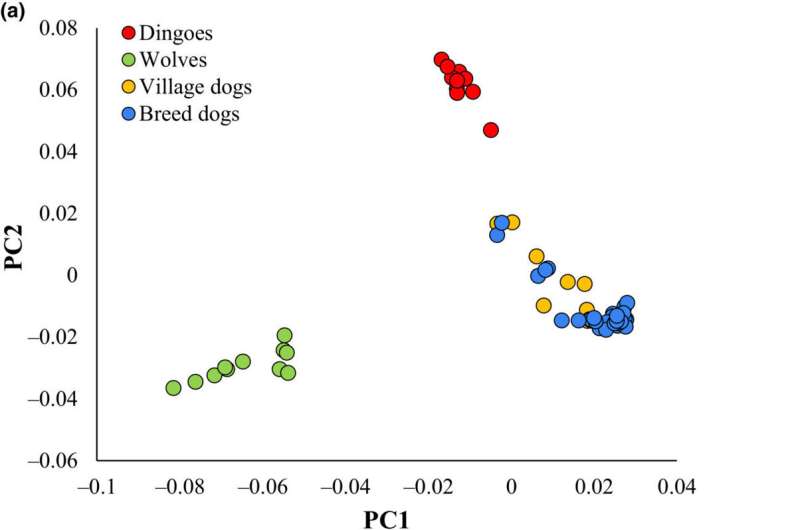This article has been reviewed according to Science X's editorial process and policies. Editors have highlighted the following attributes while ensuring the content's credibility:
fact-checked
peer-reviewed publication
trusted source
proofread
Dingoes found to have more harmful mutations than most inbred dog breeds

Genome sequencing comparisons with wolves, strays and dogs across the world has found Australia's dingoes have the highest loads of harmful mutations—and diversity levels that are 36% lower than the most inbred dogs.
The research led by the University of the Sunshine Coast established that the ancestral stock for the modern dingoes was much smaller than other canines, potentially creating a bottleneck effect that is still impacting the genetic diversity and health of populations in Australia.
As a result, the nation's largest land-based top-order predator is carrying higher loads of harmful and recessive mutations compared to other canines, increasing the threat of diseases, according to the study published in Ecology and Evolution.
UniSC Senior Lecturer in Genetics Dr. Sankar Subramanian, who led the study, said the findings helped to build our knowledge about the evolutionary history of dingoes, believed to have first arrived in Australia, most likely from South East Asia, up to 11,000 years ago.
"Our study has found genomic evidence suggesting that the founding population size of dingoes was much smaller than that of wild wolves and domesticated dogs, and this bottleneck led to a reduction in diversity and an accumulation of bad mutations."
The researchers said the findings highlighted the need to consider the genomic consequences of lethal control programs on dingo populations.
"For example, aerial baiting programs which realize a 90% population knockdown may initiate further bottlenecks and exacerbate the low genetic diversity and high mutational loads of targeted dingo populations with detrimental consequences," Dr. Subramanian said.
Investigating the dingo genome and its canine relatives
Saliva samples were used to sequence the genomes of two wild dingoes from The Kimberley in Western Australia and western New South Wales, and a captive dingo from the Alpine region.
Researchers also assembled whole genome data sets from a previous study of nine mainland dingoes.
For further context, comparisons were made with whole genome data from 11 wolves, 13 village dogs, and 32 breed dogs from various locations including the Artic, Africa, Europe, Asia and the Middle East.
Co-author, UniSC Research Fellow Dr. Manoharan Kumar, said that this included 10 of the world's most inbred dog breeds, such as the Weimaraner and Scottish Terrier, as these dogs might also have been bred using a very small number of founding individuals.
"The study found five lines of evidence for bottlenecks from the small original population, accelerating the loss of genetic variation in dingoes," Dr. Kumar said.
This included a reduction in heterozygosity (genetic variability) and the presence of a large number of contiguous RoH segments (both parents transmitting identical genes from a common ancestor) in their genomes.
"The dingo had the lowest genetic variation compared to all other canines analyzed, except for Norwegian Lunde Hund and Bull Terrier dog breeds," Dr. Kumar said.
"Groupings based on inbreeding coefficients put the dingo's mean diversity at 36% less than that of highly inbred breed dogs and about four times lower than wolves. The number of RoH segments was four times higher than in village dogs and wolves."
Three other methods showed dingoes had the highest accumulation of harmful mutations load of all domesticated dog breeds, stray dogs and wolves studied.
These were a high dN/dS ratio (low selection pressure), elevated number of homozygous deleterious amino acid changing SNVs (increasing susceptibility to a range of diseases) and loss of function single nucleotide variants (severe disease-causing variants).
The research team says the next step is a wider study including more genomes from various geographic locations to reveal any additional bottlenecks specific to different populations.
Co-author Dr. Gabriel Conroy, an ecological genetics and conservation biology expert with UniSC's Center for Bioinnovation, said greater understanding of the genomic health of dingo populations at regional and local scales was needed to inform conservation and management practices.
"Ongoing genetic monitoring of lethally controlled populations may assist managers in designing conservation-aware dingo management plans, given the important ecological role and cultural significance of dingoes in the Australian landscape," Dr. Conroy said.
More information: Manoharan Kumar et al, Genomic signatures of bottleneck and founder effects in dingoes, Ecology and Evolution (2023). DOI: 10.1002/ece3.10525
Journal information: Ecology and Evolution
Provided by University of the Sunshine Coast





















